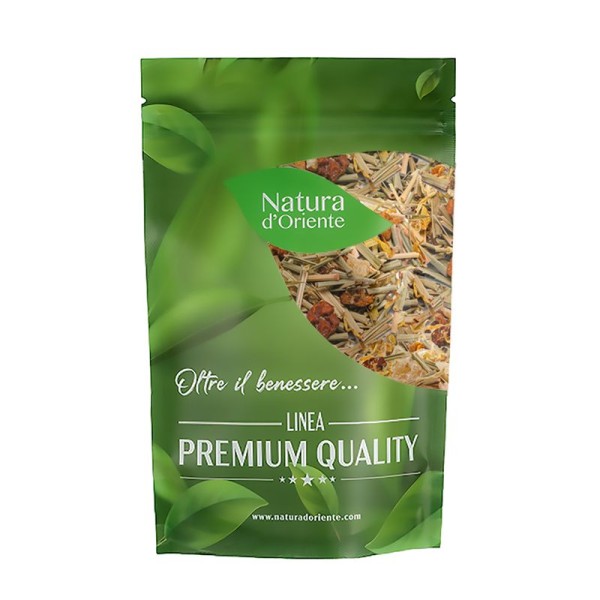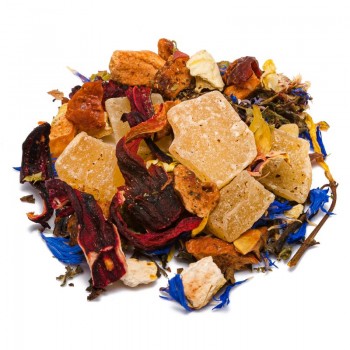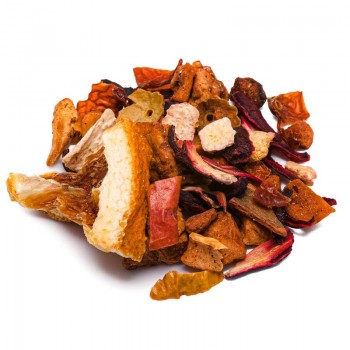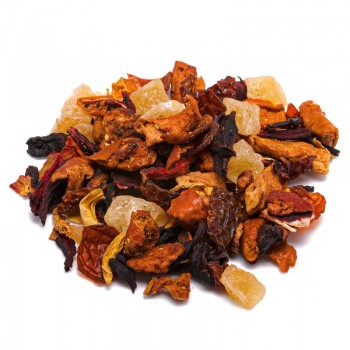The blend promises the benefits of these healthy ingredients, delivered through a rich, fruity taste with a lovely strawberry scent. The infusion also benefits from other valuable fruits and vegetal substances, which increase the aromas and also the nutritional virtues. The flavor nuances of the drink include the intensity of spring and summer fruits such as strawberry and pineapple. Floral notes of hibiscus and calendula are added, in addition to the sweet contribution of apple.
Elements that balance the tartness of lemon and the less acidic one of lemongrass: a harmonious taste experience. The infusion is thirst-quenching if enjoyed fresh, accentuating the refreshing effect based on lemongrass, lemon and strawberry. It becomes more substantial and fragrant if savored hot, with a sweet aftertaste of apple and hibiscus.
Lemon and strawberry infusion: properties and benefits
The lemon ingredient creates a dense infusion of antioxidants and detox properties. Its load of beneficial substances and vitamin C make the mixture effective for a purifying and strengthening action on the immune system. Lemon, in its antioxidant content, is also supported by other fruits and hibiscus, providing a useful infusion to fight free radicals and preserve the well-being of the body's cells - together with vitamins and precious minerals.
Strawberry and lemon are rich in vitamin C and minerals such as iron, phosphorus, magnesium and calcium. Lemon and lemongrass allow the infusion to act beneficially on digestion, purifying the body starting from the airways, continuing from the stomach and up to the colon and intestinal transit. Combining strawberry and apple, the drink becomes a panacea to counteract digestive difficulties and heaviness after meals. The hot infusion has a detox action on the digestive system and also ensures a diuretic action - which in addition to purifying, eliminates excess liquids. The contribution of pineapple and strawberries is essential, as they promote purifying diuresis. For this reason, the infusion can be an aid within detox or slimming diets, to promote the loss of swelling and counteract water retention.
Regarding the well-being of the respiratory tract, lemon and lemongrass purify from the oral cavity, providing useful elements to the respiratory system against mucus and microbes (geraniol, limonene, myrcene, citrals and others active principles). In case of throat or airway irritation, it reduces mucus levels thanks to the citric acid and vitamins it contains.
Origins and history of cultivation
The herbal tea blend features various natural elements, of which we consider the main ones: lemon and strawberry.
The origin of the lemon is unknown, although it is thought that the plant originates from Asian territory - in China, in Assam (a region of India) or in the north of Myanmar. A study has indicated that the lemon originated as a hybrid between the bitter orange and the citron, thousands of years ago. Known for centuries in Asia in the regions where it grew spontaneously, it arrived in Europe already at the time of the Egyptians and then the Romans. Lemons also became popular in Arab countries, and the word lemon derives from the Arabic laymun.
Merchants began to trade them with ever greater frequency, and in the Middle Ages they were widely used both as folk remedies and as ornamental trees and fruits. They were brought to the New World by Christopher Columbus in 1493, via lemon seeds from Spain. In addition to being consumed in various forms, lemons have been used to create medicines and beauty products. Lemon juice and oil were used in ancient times to treat common illnesses such as colds and fevers, against food poisoning and poisons. It was known as a natural antibacterial and antiseptic in an era when disinfection was done using natural remedies.
Even today, lemon is used to naturally treat diarrhea and slow digestion, and from the eighteenth century onwards it has been used for a long time as a prevention of scurvy.
Wild strawberries (Fragaria vesca) originate from the Mediterranean climate. They were already appreciated in ancient times, but not cultivated. Already mentioned by the Roman poets Virgil and Ovid in the 1st century AD, they were considered ornamental fruits, a symbol of love due to their heart shape. At that time, wild strawberries were widespread, eaten since ancient times but not in large quantities since the fruits were small, hard and in some cases with a poor flavour. In the Middle Ages the French began transplantingtare strawberries in the garden, and at the end of the Renaissance the musk strawberry (Fragaria moschata) appeared. The Virginia strawberry (Fragaria virginiana) and then the Chilean strawberry (Fragaria chiloensis) arrived from North America in the seventeenth century. It was at the end of the 1700s that the current garden strawberries began to spread. They arise from a cross between the two American strawberries, and give rise to Fragaria ananassa. In the nineteenth century, English gardeners created new varieties from seed and increased the varieties from three to almost thirty hybrids and cultivars.
Fruits and flowers
The components of the infusion are many, and the mixture includes leaves and flowers of different origins.
Lemons grow from the evergreen tree Citrus limon, of the Rutaceae family. They grow best in tropical climates characterized by heat and humidity, while they are very sensitive to cold. With this climate, the plant can tolerate poor soil and grow easily. Today we find different varieties, over 20 different types of lemons grown all over the world. They can grow up to 33 feet tall and the branches have thorns and shiny green leaves. When the lemon tree flowers, it produces small white flowers. Between the end of summer and the beginning of autumn, the famous citrus fruits are born that can be harvested from the tree.
Strawberries come from plants of the Fragaria genus, of the Rosaceae family. The most common strawberries grown are cultivars of the garden strawberry, the hybrid Fragaria × ananassa.
Strawberry cultivars vary in size, fruit color and shape, and in ripening season. They love fertile, well-drained soil and produce flowers that have both male and female parts on each bloom. The fruits can be harvested in different seasons, based on the variety of the plant.
The Malus domestica plant of the Rosaceae family gives apples. It is a tree native to Asia, now widespread throughout the planet. The fruits vary in color and in many varieties, and have been used in human nutrition for millennia.
Lemongrass comes from the Cymbopogon nardus plant, of the Poaceae family. It is a cross between a scented geranium and lemongrass. Native to southern Asia, it has very long, intense green leaves. It grows up to approximately 2 meters, and is also used for the production of lemongrass oil.
Hibiscus derives from Hibiscus sabdariffa, a flowering plant native to India and Malaysia. There are hundreds of types of hibiscus, and the shrub variety sabdariffa is grown for its large pink and red flowers. Both the flowers and the leaves and stems are used for various cosmetic and medicinal preparations. Hibiscus tea is obtained from the flowers.
Ananas comosus is a plant of the Bromeliaceae family. It grows best with excellent sun exposure, very slowly – it takes up to 2 years to reach full maturity. Purple, pink or red flowers arise from the plant, while the fruits have a shape that resembles a pine cone. Flowers and berries of the plant, which come together to form a single fruit that we know as pineapple.
Calendula officinalis is a herbaceous plant that grows to around 70 centimetres. The yellow-orange flowers are used, which is why it is also called fiorrancio, and are known for their beneficial and soothing cosmetic properties.
Nutritional values of lemon and strawberry infusion
The main active ingredients of the infusion are vitamin C and nutrients such as vitamin B, calcium, iron, magnesium, potassium and zinc. Contains phytochemicals such as antioxidants polyphenols and terpenes, pinenes and limonenes. Makes organic acids available such as malic acid, citric acid, ascorbic acid (vitamin C).
How to use the ingredients in the infusion
The infusion is obtained by placing approximately 3-5 grams of the lemon and strawberry mixture with water at 100 °C in a cup (250 ml). Leave to infuse for 10 to 12 minutes before drinking. Add honey or sugar, if desired.
Lemon and strawberry infusion: side effects and contraindications
This fruit infusion is generally safe, but it is important not to exceed the recommended doses, and not to take it for too long periods. Excessive intake can cause stomach ache, nausea, headache, gastrointestinal irritation. Strawberries have an allergenic effect, so be carefulfor those who suffer from allergies to this fruit; For allergy sufferers, we recommend evaluating all the ingredients of the infusion.











 No reward points for this product.
No reward points for this product.





![infuso pesca melone [Natura d'Oriente]](https://www.naturadoriente.com/3535-home_default/infused-peach-melon.jpg)









